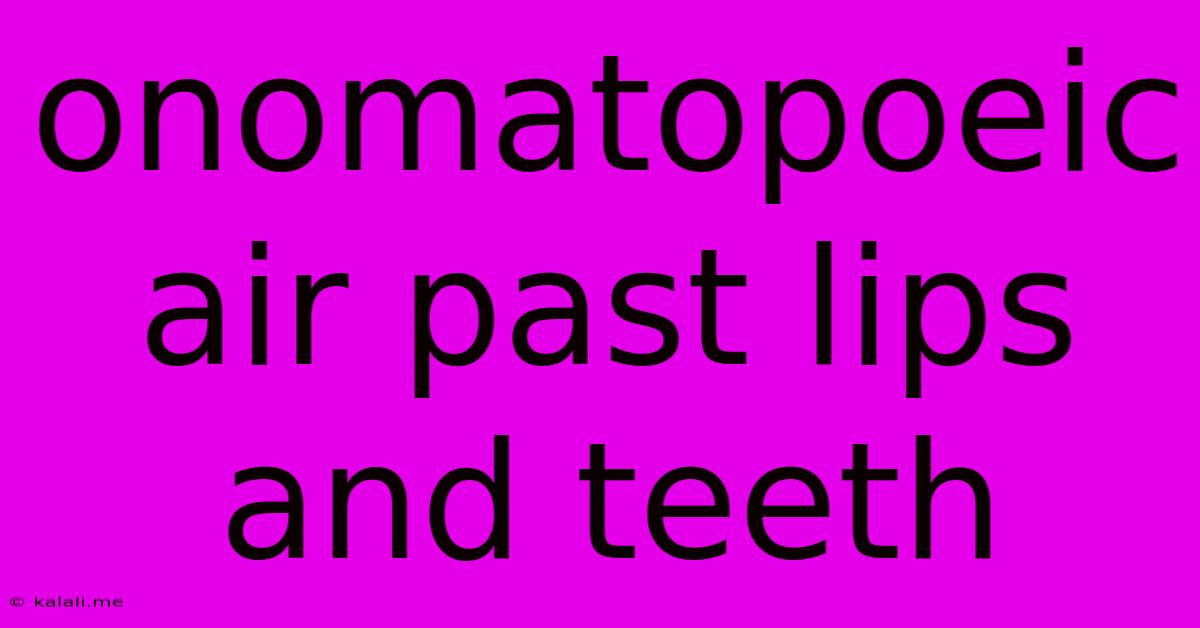Onomatopoeic Air Past Lips And Teeth
Kalali
May 24, 2025 · 3 min read

Table of Contents
Onomatopoeia: The Airy Sounds of Lips and Teeth
The human mouth, a marvel of articulation, produces a vast array of sounds, many of which are inherently onomatopoeic. This article delves into the fascinating world of onomatopoeic sounds created by the movement of air past the lips and teeth, exploring their linguistic diversity and the subtle nuances they convey. We'll examine how these sounds are formed, their cultural variations, and their applications in creative writing and beyond.
The Mechanics of Airflow
The sounds we're exploring are fundamentally created by the manipulation of airflow. The precise shape of the mouth, the position of the tongue, and the tension of the lips and teeth all contribute to the unique character of each sound. For example, the simple act of blowing air through pursed lips produces a sound like "phoo" or "poof", depending on the force and duration. This differs significantly from the hissing sound of air forced between the teeth, often represented as "sss" or "shhh." The subtle variations in these sounds communicate a range of emotions and actions, from a gentle breeze to a forceful gust.
A Cross-Cultural Exploration
While many onomatopoeic words are language-specific, some share remarkable similarities across cultures. The sound of a gentle breeze might be represented by "whoosh" in English, while other languages might use similar-sounding words with slightly different nuances. Similarly, the sound of a sharp intake of breath, often written as "hiss," holds a fairly consistent representation across various linguistic backgrounds, although the specific spelling may vary. This highlights the inherent, almost universal nature of some onomatopoeic expressions. However, the cultural context significantly impacts the interpretation and usage. For instance, the sound of a kiss might be represented differently depending on the culture, reflecting varied customs and expressions of affection.
Onomatopoeia in Literature and Beyond
The expressive power of onomatopoeic words relating to air passing the lips and teeth is widely exploited in creative writing. Authors frequently use these words to paint vivid auditory pictures for their readers, adding depth and realism to their descriptions. Consider the evocative power of words like "whisper," "wheeze," "whistle," and "sigh" in conveying atmosphere, emotion, and character. These sounds not only represent the sounds themselves, but also the emotions or actions associated with their production. For instance, a "sigh" not only describes the sound of exhaled breath, but also hints at feelings of relief, tiredness, or disappointment. Similarly, a "whisper" conjures a sense of secrecy or intimacy.
Beyond Simple Sounds: Nuance and Context
It's important to note that the meaning and interpretation of these onomatopoeic words extend beyond their literal phonetic representation. Context plays a crucial role. The same sound, such as "puff," can represent a small gust of wind, a smoker exhaling, or even a disgruntled expression. The surrounding text and the overall narrative heavily influence the reader's interpretation. The effective use of these onomatopoeic words therefore requires a careful consideration of their intended effect and the overall context of the piece.
Conclusion: The Breath of Language
Onomatopoeic words representing the movement of air past the lips and teeth are a fascinating testament to the close relationship between sound and language. Their versatility in conveying both literal and figurative meaning makes them invaluable tools in creative writing, contributing to richer, more engaging narratives. Understanding their mechanics, cultural variations, and nuanced applications deepens our appreciation for the expressive power of language itself.
Latest Posts
Latest Posts
-
Whats The Cheapest Way To Make Espresso
May 25, 2025
-
How To Make Antique Looking Polaroid
May 25, 2025
-
How Long Can Bacon Sit Out
May 25, 2025
-
See Product Reviews In Magento 2
May 25, 2025
-
What Does Is It Pink Mean
May 25, 2025
Related Post
Thank you for visiting our website which covers about Onomatopoeic Air Past Lips And Teeth . We hope the information provided has been useful to you. Feel free to contact us if you have any questions or need further assistance. See you next time and don't miss to bookmark.